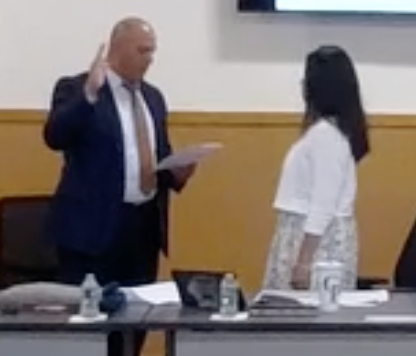
The Village of Westbury Board of Trustees voted on Oct. 3 to accept the Final Generic Environmental Impact Statement (FGEIS) for its proposed rezoning of a significant area near the railroad station.
Under the bland title “Proposed Amendments to the Village of Westbury Zoning Code” it aims at nothing less than transforming about 53 acres of a current light industrial and industrial zone into the “Maple Union Triangle Rezoning Area.”
It envisions a mixed-use transit-oriented development consisting mainly of housing but also some retail.
The rezoning is perhaps the most consequential component of the $10 million Downtown Revitalization Initiative (DRI) grant that the village won in 2016, the first from Long Island to earn that distinction. Governor Andrew Cuomo came to town to present the ceremonial check.
Mayor Peter Cavallaro, at a July meeting that discussed the zoning, said of the area: “Not to denigrate those properties, but it really is the only degraded or underutilized portion of the village.”
The area, Cavallaro told the September meeting attendees, consists of “dozens of property owners and dozens of pieces of property—all with different attributes.”
The proposed zoning, he added, is designed to give the board maximum flexibility to approve or disapprove a particular project.
When a resident questioned a provision in the code that allows developers to make monetary contributions as part of a package of incentive bonuses, Cavallaro replied, “We don’t know what an application will look like. We don’t know what’s going to be proposed. But by allowing the board to consider the payment of money to the village—either in lieu of or in addition to other public benefits that they are required to supply, it affords the village the maximum flexibility to determine what’s appropriate for that particular property.”
He added, “We may never see an application that has a payment, but for us not to include that as a possibility in the code would leave us with less flexibility.”
The code, Cavallaro again emphasized, is not to pigeonhole the board into facing the possibility that it will have to turn down a particular project because it’s not allowed by the code.

“We want to have every tool at our disposal to make the best product out of that rezoning and that’s best for our village,” Cavallaro affirmed. “One that creates more affordable housing, more housing for seniors, more housing for millennials and more housing for veterans.”
“I think if it’s done and executed the way we think we can do it, it’s going to be good,” Cavallaro continued. “We know where we want to go with it and what we intend by it.”
Though, as the mayor has emphasized at various meetings, Westbury remains primarily a single-home suburb, it has changed. Within the past 15 years more than 800 units of multi-family housing (apartments, co-ops and condos) have been built, most near the downtown business area.
But these projects were approved under a different code and for the most part are at market rates.
The new code will mandate that developers must set aside 10 percent of their units for affordable housing.
“We want [in the new area] to replicate housing at every price point that exists in the village and will maintain the flavor of our community,” Cavallaro explained. “Our community has a diversity of housing that most communities don’t have. You have houses in the village that have sold for $1 million, and you have more modest houses that sell in the $300,000 range. You have apartments at every level.”
He observed that other municipalities have erected market-rate housing that commands rents in the $4,000 to $5,000 per month range.
Though he welcomes such renters because it will help the village, he again is looking for a diversity of housing offerings to increase the population and provide consumers for the thriving downtown business area.
“The proposed code will encapsulate the things that will help us move things to the next level, and still maintain what’s great about this place, which is the diversity of everything—food, religions, ethnicity, income levels,” Cavallaro stated. “Not too many communities on Long Island have that kind of blend. And we also have a [main line LIRR] train station that can be leveraged.”
Housing In Perspective
Vision Long Island has been at the heart of the numerous downtown transformations in such villages as Farmingdale, Wyandanch and Westbury.
The Westbury Times asked Vision Executive Director Eric Alexander, a familiar figure at DRI-related meetings at village hall, to weigh in on the future of housing in our region. He responded, via email: “Long Islanders will always love their single-family homes, but increasingly, additional housing options are needed. Aging baby boomers who don’t want the cost and time of maintaining a single family home but do not want to retire to Florida away from families and social networks are filling up existing downtown transit oriented developments. Generation Xers that want the experience of living on Main Street with ample food, music, art and cultural diversity available also inhabit a strong amount of the existing downtown housing stock. Lastly ,the millennials see apartment living as an option as they need to be mobile and follow their job opportunities. For this group, single family homes are less likely to be an option for economic reasons but many also seek to be closer to a downtown area and are comfortable living in smaller spaces. For all age groups affordable housing is needed and widely sought out as the region’s cost of living, taxes and relatively flat wages have stretched the budgets of single people, working families and seniors.
“The code we’re trying to adopt will be a model for other communities,” Cavallaro concluded. “We took examples of the best [elements] from other villages and created some stuff of our own.”
Copies of the FGEIS are available for public review and comment at village hall and the Westbury Memorial Public Library. It is also available electronically at www.villageofwestbury.org.

































